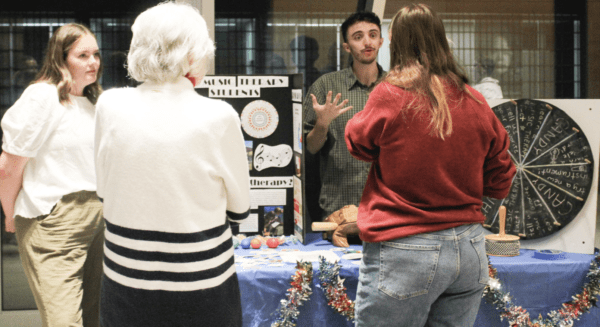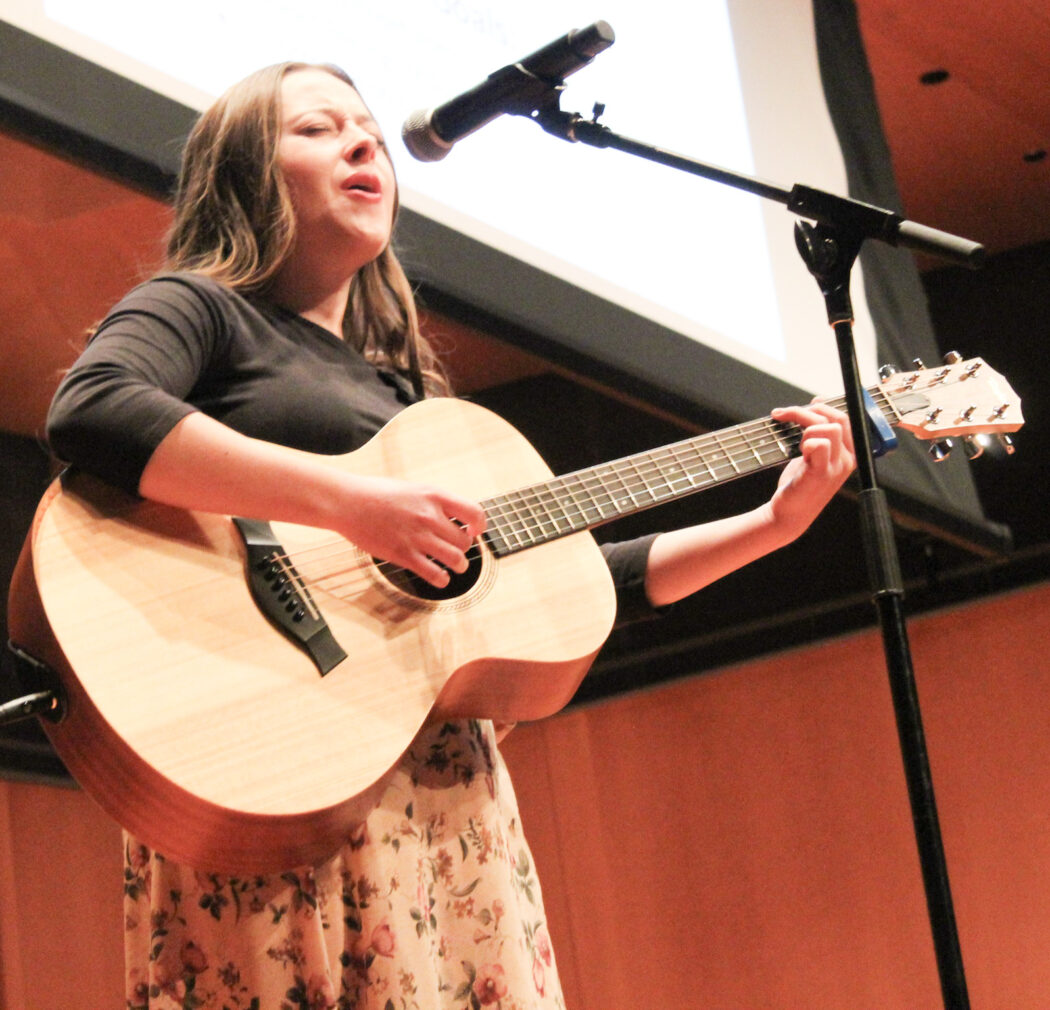MUSES: Healing through song
Utah State University’s Music Therapy Student Association hosted the MUSES: Serenade for the Senses concert on Nov. 4. The annual showcase is a chance for the USU community to get a taste of music therapy.
The concert showcases a variety of real-world therapeutic applications utilized every day in music therapy sessions. USUMTSA invited attendees to participate in these same activities during its interactive lobby experience directly before the show.
Fourth-year music therapy student and USUMTSA president Ben Kaufman was behind many of the proceedings of this year’s concert.
“You’ll hear songs tonight that you might recognize,” Kaufman said. “On the screen will be the clinical application, how we use it and goals for the song that we might use with different populations. This is to try to get an idea of the diverse populations and diverse points of view to help clients with their goals.”
Members of USUMTSA are using real-world processes with the techniques showcased to the public in the music therapy program.
Kaufman got his start in music therapy in 2021 when he found his passion for giving clients an outlet and a connection through music.

“I was originally a performance major — a piano performance major — and I decided that was not the route that I wanted to take, so I auditioned for this program,” Kaufman said.
The audition process for the music therapy program is extensive, ensuring those who are in the program want to enter music therapy as a career. Students must demonstrate musical proficiency by performing piano, guitar and their primary instrument and singing.
Phoebe Bair is a fourth-year student in the music therapy program with a cello emphasis.
“There’s also a one-on-one interview. You answer some questions, you do essays and find recommendations,” Bair said. “It’s just making sure that you know what music therapy is and can work with people.”
According to Bair, the process has paid off in the form of a highly successful program.
“We’re actually one of the most competitive music therapy programs in the U.S., and we have a 99% pass rate for the board certification exam on the first time, which is very unusual,” Bair said.
Once students are accepted into the program, they immediately begin work on gaining clinical experience.
“We do four semesters of practicum where we are with actual clients, like in assisted living, in special education or one-on-one,” Kaufman said.
Music therapists form bonds with their clients fostered by a deep mutual passion for playing music.
According to Kaufman, one memorable experience has impacted his career as a music therapist for the better.
“I was in a special education room setting with some second graders during Halloween time,” Kaufman said. “I wrote this original song intervention as something else we do in the program — you write a lot of original songs for clients just to build up those skills.”
The ability to write songs and incorporate them into a clinical setting is another crucial skill for a music therapist to have.
“The purpose of this song was to kind of be a social story about Halloween and trick-or-treating,” Kaufman said. “I talk through like, ‘When you get to the door, what do you say?’ And they would yell back, ‘Trick or treat!’ And it was just really fun to create that song for them and help them work on social skills.”
The versatility of music therapy allows for therapists to incorporate a wide range of unique, creative ideas into the sessions as a means of connecting with a client.
“I’ve used Squishmallows, and they absolutely loved it,” Kaufman said. “I remember how excited they would get when I would bring out the Squishmallows. That’s something really fun about music therapy is that we can use so many different props and mixed modalities.”
Bair has been working at Primary Children’s Hospital this semester. She said she finds beauty in everyday moments as a music therapist.
“I had a session last week with a little girl where the nurses were like, ‘She’s in a really bad mood today and is not having a good time,’” Bair said. “We started singing some songs that she liked from ‘Frozen.’ As soon as we started singing with her, she just totally changed. She was singing along to every word. She was just about to go into a procedure and instead of being super stressed and anxious, she was having a great time.”
Bair and Kaufman came together at the MUSES concert, donning frog hats to perform “Rainbow Connection” by Paul Williams and Kenneth Ascher. Attendees sang along, reminiscing the popular tune from the 1979 film “The Muppet Movie.”
The performance was aimed towards adolescent populations. According to Kaufman and Bair, the mental health group would then look at copies of the lyrics and underline what personally spoke to them, and afterwards they would discuss.
Emotional processing, hope for the future and social connection were the primary goals of the song’s activity.
The rest of the concert was full of performances from the USUMTSA members. They each end their sessions with a goodbye song, and the MUSES concert was no different.
All the performers of the night reunited on stage to send the audience off with one final song entitled “You Can Do It,” hoping to leave the audience with a final note of confidence and positive energy.

